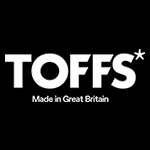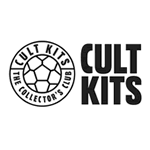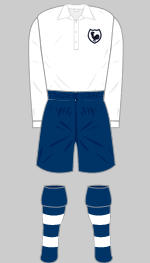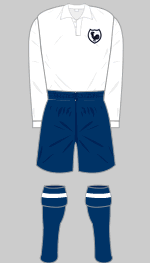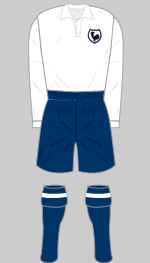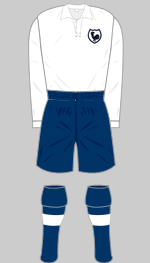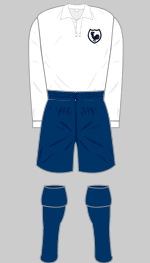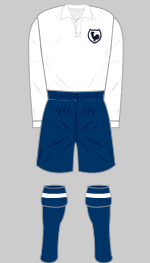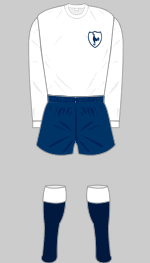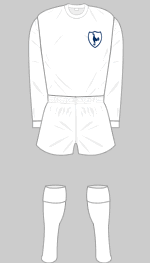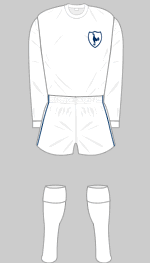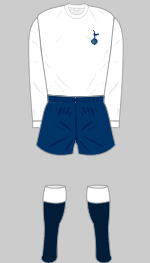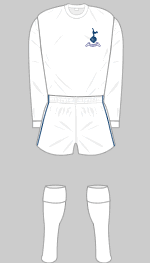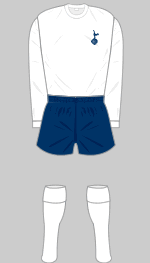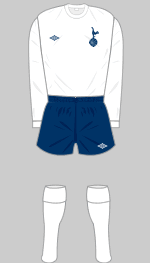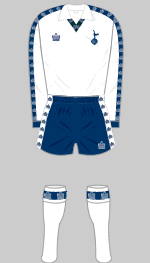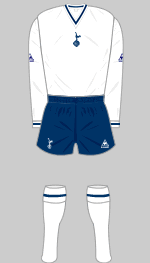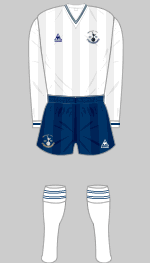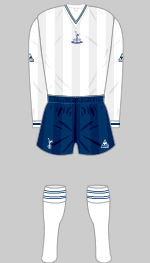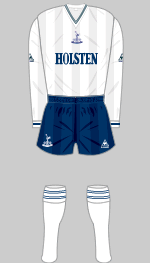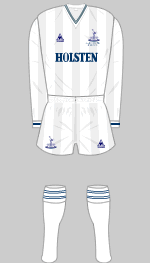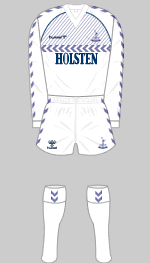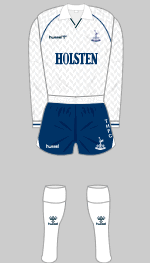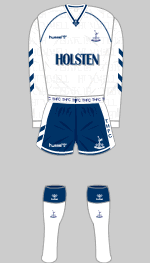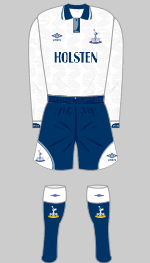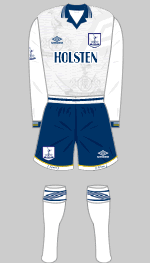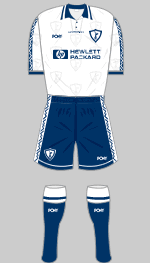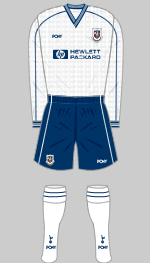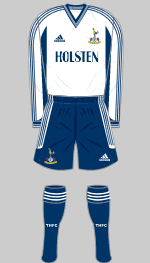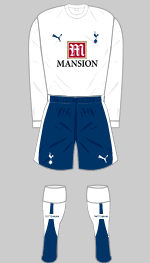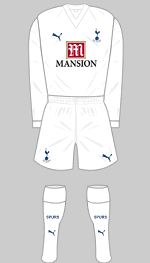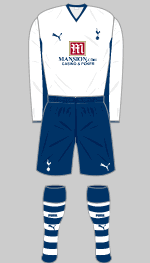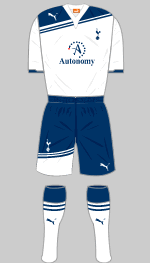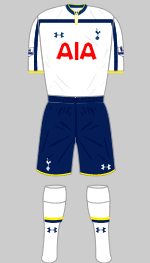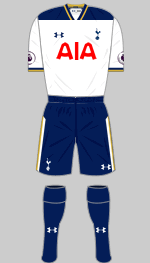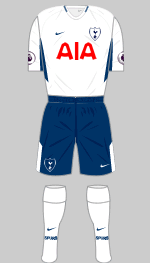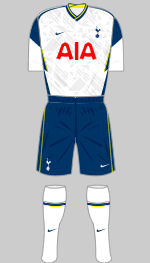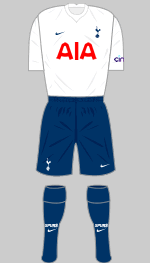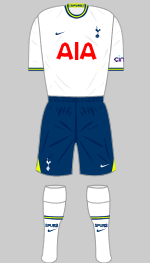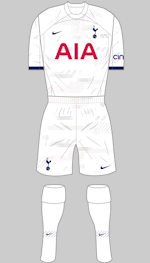Kit History
Hotspur
1882
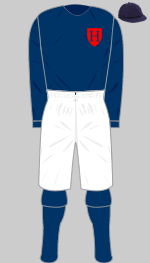
1883-1884 (1) a d n u
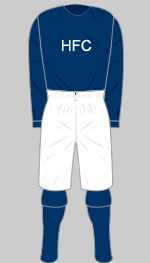
1883-1884 (2) n u
Tottenham Hotspur
1884
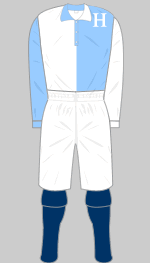
1884-1885 n
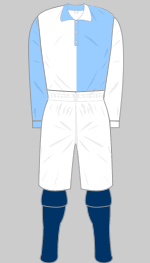
1885-1889 1 n
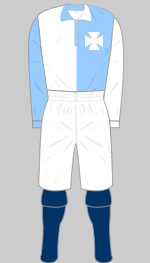
1885-1886 2 a d n o
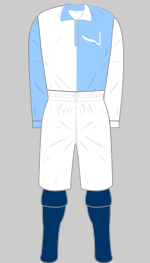
1886-1888 2 n
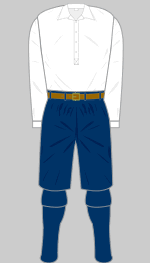
1889-1890 n q
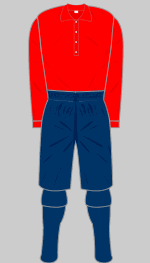
1890-1896 a d
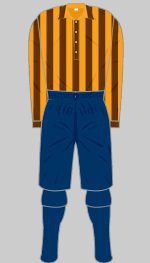
1896-1898 a d n o
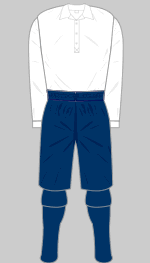
1898-1903 a d n
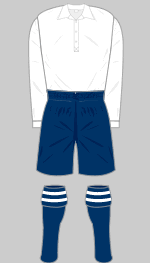
1903-1911 p
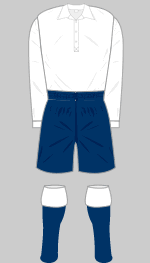
1911-1912 a n
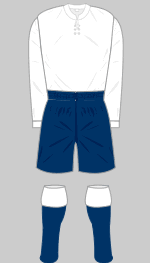
1912-1914 d n p
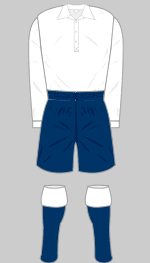
1914-1919 a h n p
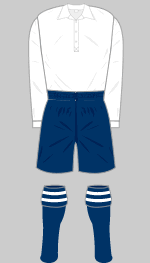
1919-1920 p
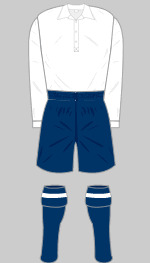
1920-1921 n
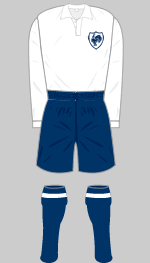
1921-1923 d n p t
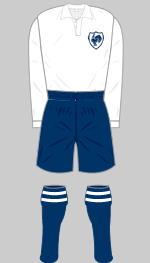
1923-1926 k n t
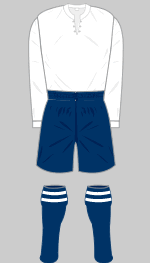
1926-1927 alt t

1926-1930 n
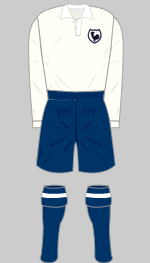
Sept-Dec 1930 a n p t
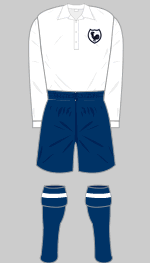
Jan 31-1933 t

1932-Oct 1933 alt n
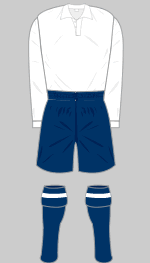
1946-Jan 1947 p
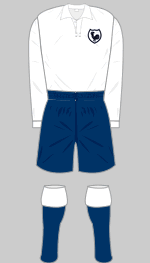
Sept 1947-1948 a n p
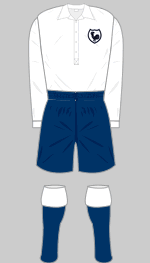
Aug-Oct 1948 n
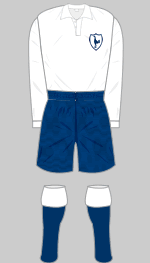
1951-1955 d n
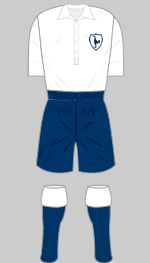
1951-1955 alt n
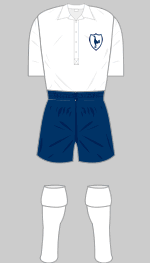
October 1954 n
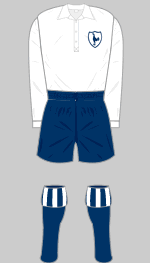
Feb & April 1955 j n
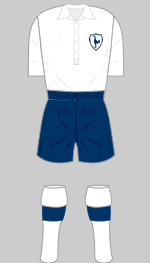
May 1955 n
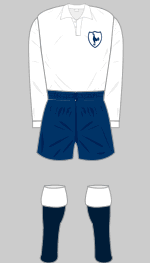
1955-March 1956 p
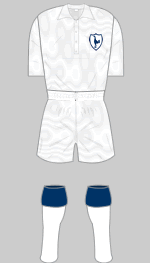
Sept-Dec 1956 n u
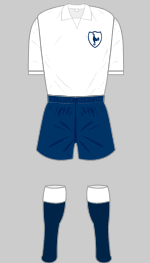
Mar 56-Mar 57 i n
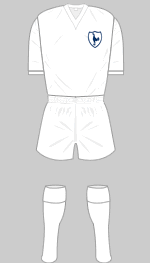
1961-62 EUR n*
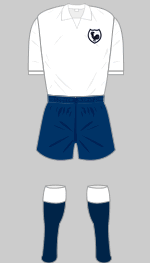
April 1957 n

1957-1959 i
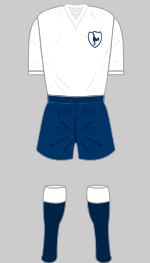
1959-1961 e n
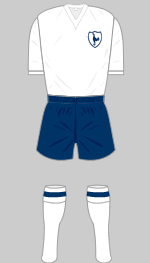
1960-1961 alt n
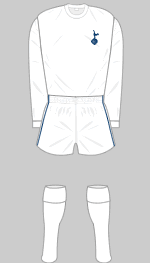
1966-77 EUR/FAC
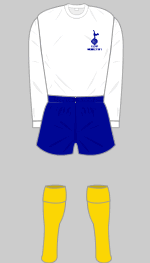
1971 FL Cup Final n
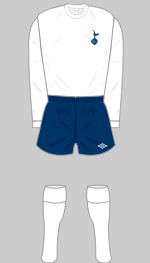
1976-1977 n
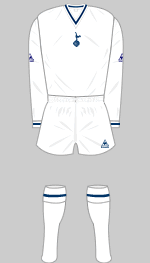
1981-1982 EUR n
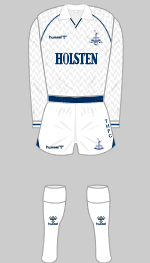
1987 FA Cup Final
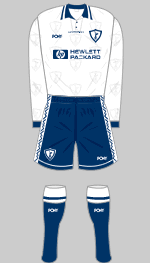
1995-1997 (1) b n
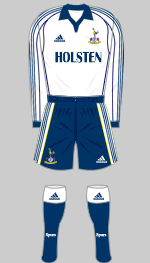
1999-2001 b f n
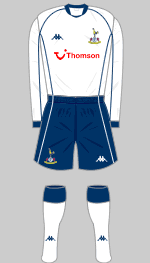
2002-2004 a
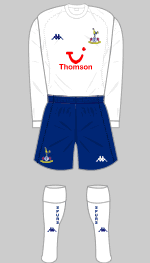
2004-2005 a
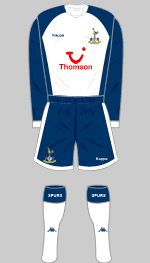
2005-2006 a
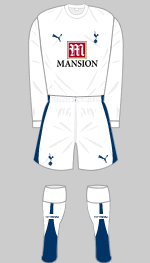
2006-2007 EUR n
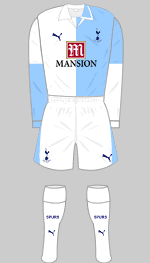
Anniversary 2007 a
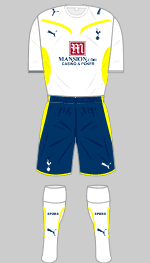
2009-2010 a
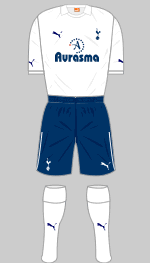
2011-2012 a
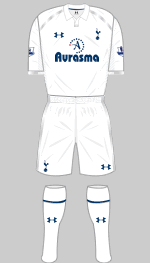
2012-2013 a
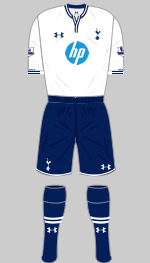
2013-2014 a
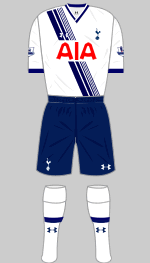
2015-2016 a
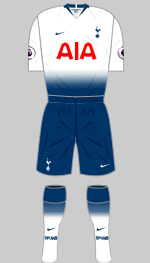
2018-2019 a
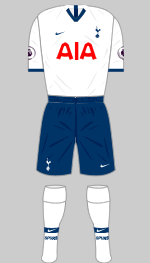
2019-2020 a
Background
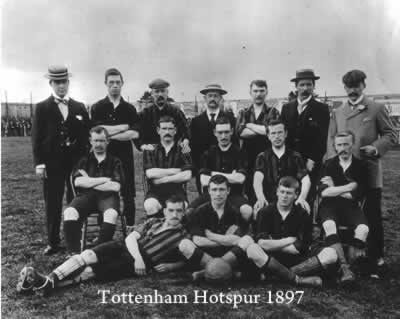 In 1882 a group of North London
teenagers formed Hotspur FC, named after the combative Henry Percy, "Harry
Hotspur" of Shakespeare's Henry IV (Part I) whose descendents owned
land in the neighbourhood. There are no records of what the team wore in their first season but, as they played just two matches, is is likely the boys wore whatever they could get hold of. At the club's first AGM in August 1883 it was agreed that the club colours would be "dark blue jerseys, white breeches, dark blue stockings and cap." The Romance of Football (1921) adds the information that a scarlet shield emblazoned with the letter "H" was worn on the left side of the jersey.
In 1882 a group of North London
teenagers formed Hotspur FC, named after the combative Henry Percy, "Harry
Hotspur" of Shakespeare's Henry IV (Part I) whose descendents owned
land in the neighbourhood. There are no records of what the team wore in their first season but, as they played just two matches, is is likely the boys wore whatever they could get hold of. At the club's first AGM in August 1883 it was agreed that the club colours would be "dark blue jerseys, white breeches, dark blue stockings and cap." The Romance of Football (1921) adds the information that a scarlet shield emblazoned with the letter "H" was worn on the left side of the jersey.
The name was changed to Tottenham Hotspur in April 1884, possibly
to avoid confusion with the older Hotspur FC (formed 1878 and located in Wimbledon by 1886). For a while the lads turned out
on 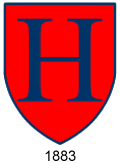 Tottenham Marshes and scuffles occasionally broke out with rival teams
over the best pitches. In 1884 the club cancelled a fixture to watch the
professionals of Blackburn Rovers win the first of three consecutive English
Cup finals. So impressed were they that the club adopted Rovers' blue
and white halved shirts with the letter "H" embroidered "near the shoulder." In 1885 Spurs entered the London Association
Cup and played their first competitive match against St Albans FC, winning
2-0. A photograph taken before this game indicates that a Victoria Cross appeared on the chest. The club's minute book (10 June 1885) records that this item was added specifically for cup matches so presumably plain shirts were worn in other games.
Tottenham Marshes and scuffles occasionally broke out with rival teams
over the best pitches. In 1884 the club cancelled a fixture to watch the
professionals of Blackburn Rovers win the first of three consecutive English
Cup finals. So impressed were they that the club adopted Rovers' blue
and white halved shirts with the letter "H" embroidered "near the shoulder." In 1885 Spurs entered the London Association
Cup and played their first competitive match against St Albans FC, winning
2-0. A photograph taken before this game indicates that a Victoria Cross appeared on the chest. The club's minute book (10 June 1885) records that this item was added specifically for cup matches so presumably plain shirts were worn in other games.
The minute book for May 1886 records Spurs colours as "blue and white." While this may imply a darker shade was introduced, fixture books that came to light in December 2023 confirm that they were in fact light blue. For cup games in 1887-88 the club rules stated that a (fighting cock) "spur" would be worn on the left breast.
In 1888 the club moved to an enclosed ground at Northumberland Park and charged 3d (1p) admission.
At the AGM held on 14 May 1889 it was resolved that the team colours be changed to "white shirt with dark blue britches." In 1890, now playing in red shirts and navy shorts, Spurs were a respected side and five years later, they turned professional.
A new chocolate and old gold strip was worn for the first time in October 1895 against Royal Artillery. The following season Tottenham were elected to the Southern League and in 1899 they moved into White Hart Lane.
While earlier sources variously state that Spurs permanently adopted white shirts in 1899 or 1900, the club's historian, Andy Porter has provided HFK with a copy of an article published in The Golden Penny dated September 1898 which carries a photograph of the Spurs team wearing white shirts and navy knickers. Andy's research has subsequently been confirmed by Tony Sealey and Simon Shakeshaft from the Tottenham Weekly Herald (15 July 1898). The shirts were supplied by Dumbleton & Co of 501 Tottenham High Road. At the time, no other team in the Southern League wore similar colours.
In 1900 Spurs won the Southern League championship and in 1901 the FA Cup. Tottenham are the only non-League side to have won the trophy since the Football League was formed in 1888.
In 1908 Spurs application to join the Football League was rejected but when Stoke FC resigned a second meeting was called. After two tied votes between Spurs and Lincoln City it was the London club who prevailed by decision of the management committee. A year later Spurs won promotion to Division One. A former player, William James Scott, commissioned a copper casting of a cockerel standing on a football, which was placed above the West Stand. This motif was inspired by Harry Hotspur, after whom the club is named, who is reputed to have been a devotee of cock-fighting.
In 1915 the club was relegated but then the League
was suspended for the duration of the Great War. When competition resumed
in 1919 it was decided that both divisions would be extended by two clubs.
Precedent suggested that the relegated clubs would retain their status
but the chairman of Woolwich Arsenal, after vigorous lobbying, persuaded
members that there should be a vote. Spurs' relegation was confirmed and
their place in the First Division given to Woolwich Arsenal. Although
Spurs won promotion at the first attempt, the 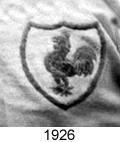 injustice of these machinations
injustice of these machinations
In 1921, Tottenham won the FA Cup again wearing, for the first time, the cockerel motif mounted on a shield. Due to this success, the crest became a permanent feature on Spurs' shirts from the following season. This is the first example of an "animal crest" being 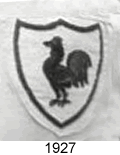 worn in the Football League. The version shown on the right dates from 1926-27 but appears to be identical to the original 1921 design. The badge worn between 1927 and 1930 (left) is slightly different with the cockerel standing more upright and having a narrower profile.
worn in the Football League. The version shown on the right dates from 1926-27 but appears to be identical to the original 1921 design. The badge worn between 1927 and 1930 (left) is slightly different with the cockerel standing more upright and having a narrower profile.
In 1922 Spurs were Division One runners-up but 1928 brought relegation.
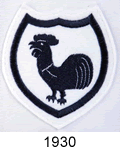 A new version of the cockerel crest was introduced in 1930 which was positively portly and for the first part of the season this was worn on off-white cashmere shirts with white cotton collars. These luxurious tops were replaced half way through the season but reappeared in 1932-33 as an alternative to their regular white cotton tops. In fact the team frequently changed into the cashmere tops at half-time, leading the Daily Express to describe them as the team's lucky shirts. In 1937 Umbro supplied the club with their latest Tangeru shirts made from Peruvian cotton and these remained in use until 1955.
A new version of the cockerel crest was introduced in 1930 which was positively portly and for the first part of the season this was worn on off-white cashmere shirts with white cotton collars. These luxurious tops were replaced half way through the season but reappeared in 1932-33 as an alternative to their regular white cotton tops. In fact the team frequently changed into the cashmere tops at half-time, leading the Daily Express to describe them as the team's lucky shirts. In 1937 Umbro supplied the club with their latest Tangeru shirts made from Peruvian cotton and these remained in use until 1955.
When the League resumed after World War Two Spurs
enjoyed a meteoric rise under manager Arthur Rowe who pioneered the "push
and run" style. Promoted in 1950, they 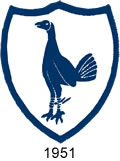 were League champions in 1951.
were League champions in 1951.
In 1951, the famous club crest was given a face lift and now featured a slimline cockerel complete with fighting spurs. The old version appeared at least once in the 1951-52 season and both long and short sleeved shirts were worn until the new "continental" strips were adopted in 1956. A fashionable kit made from shiny artificial fabric was sometimes used between 1951 and 1953 under floodlights and during 1954-55 the club experimented with different styles of sock.
In 1961, Bill Nicholson, a member of the 1951 championship team and now manager, led Spurs to the first League and FA Cup double of the twentieth century. A year later, Spurs won the FA Cup again and in 1963 they became the first British team to take European honours when they won the European Cup-Winners' Cup. Inevitably this glorious side, featuring Jimmy Greaves, Danny Blanchflower, Dave Mackay broke up. Spurs wore all-white strips in friendly games against Racing (1956-57), Moscow Torpedo (1959-60) and against Sheffield Wednesday at Hillsborough in 1959-60. During the 1960s Bill Nicholson began the tradition of wearing all-white strips in European competition and in the FA Cup. While it is widely reported that this was a tribute to the great Real Madrid team, there is no evidence to support this and it may simply be that all-white was more visible under floodlights. (*The first occasion that all-white was worn in the Football League was against Wolves in March 1959.)
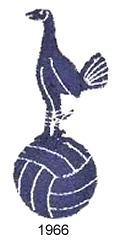 The short sleeved shirts worn since 1959 were replaced by long sleeved versions with crew necks for the European Cup Winner's Cup match with Rangers on 31 October 1962 and these became the team's first choice from November 1962.
The short sleeved shirts worn since 1959 were replaced by long sleeved versions with crew necks for the European Cup Winner's Cup match with Rangers on 31 October 1962 and these became the team's first choice from November 1962.
In 1966 a new, more modern cockspur crest was adopted. A streamlined cockerel now 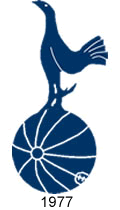 stood upon a football without a surrounding shield. This was made larger on the 1975-76 shirts at the behest of new manager Terry Neill who thought the old Cockspur needed a lift.
stood upon a football without a surrounding shield. This was made larger on the 1975-76 shirts at the behest of new manager Terry Neill who thought the old Cockspur needed a lift.
The badge was updated in 1977 , paradoxically, with a Victorian football, a reminder of Spurs' long history.
While League honours eluded them, Spurs became formidable cup competitors. The FA Cup was won in 1967, the League Cup in 1971 and 1973 while the UEFA Cup found its way to White Hart Lane in 1972.
After a brief sojourn in Division Two (1977-1978),
Spurs achieved a transfer coup by signing Argentine World Cup winners
Ossie Ardiles and Ricky Villa. Villa inspired a dramatic 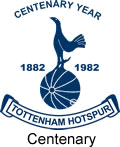 FA Cup win in
1981 and in 1982 the club retained the cup.
FA Cup win in
1981 and in 1982 the club retained the cup.
To celebrate their centenary in 1982, the club crest was suitably embellished. The new kit featured the first example of shadow stripes printed into the fabric, a style that became very popular in following seasons.
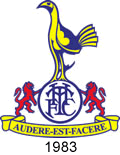 To combat the growing threat of illegally made pirate replica kits, the decision was taken to introduce a new crest in 1983. The design was deliberately more complex and now included two lions supporting the club's monogram as well as the club's Latin motto, which translates as "To dare is to do." This version was used until 1995.
To combat the growing threat of illegally made pirate replica kits, the decision was taken to introduce a new crest in 1983. The design was deliberately more complex and now included two lions supporting the club's monogram as well as the club's Latin motto, which translates as "To dare is to do." This version was used until 1995.
In 1984 Spurs won the UEFA Cup for the second time and in 1987 they were beaten FA Cup finalists.
In 1987 Terry Venables was recruited from CF Barcelona
as the new manager. After surviving a financial crisis, Spurs won their
eighth FA Cup in 1991 and once again marked the occasion by introducing
another innovative strip, featuring long, generously cut shorts. Venables
was controversially sacked by Executive Chairman Alan Sugar in 1993, an
affair that rumbled through the courts for several 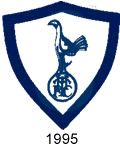 years.
years.
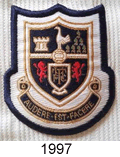 In 1995 another new crest was introduced, resembling the one worn in the Fifties but on a rather oddly shaped shield. This appeared for two seasons before it was replaced by a very much more complicated coat of arms. In addition to the usual motifs, this crest featured a castle, alluding to Bruce Castle, a local land mark, and a group of trees, referring to the Seven Sisters of Tottenham after whom Seven Sisters Road is named. This badge was also used for two seasons before the 1983 crest was reintroduced.
In 1995 another new crest was introduced, resembling the one worn in the Fifties but on a rather oddly shaped shield. This appeared for two seasons before it was replaced by a very much more complicated coat of arms. In addition to the usual motifs, this crest featured a castle, alluding to Bruce Castle, a local land mark, and a group of trees, referring to the Seven Sisters of Tottenham after whom Seven Sisters Road is named. This badge was also used for two seasons before the 1983 crest was reintroduced.
In 1999 ex-Arsenal boss George Graham became manager in a move that most fans saw as a betrayal of the club's heritage of open, attacking football but which did bring a League Cup win in 1999. Graham left, also in controversial circumstances a year later and since then a succession of high profile managers have attempted to bring back the glory days but with limited success.
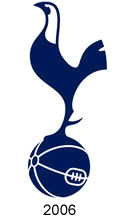 In 2006, as part of an exercise to modernise the club's image, a smart new crest was introduced. To all intents and purpose, this was very similar to the popular badge worn between 1967 and 1982 but with cleaner lines. Although the official crest has the words "Tottenham Hotspur" below the ball, this wording is not present on the players' shirts.
In 2006, as part of an exercise to modernise the club's image, a smart new crest was introduced. To all intents and purpose, this was very similar to the popular badge worn between 1967 and 1982 but with cleaner lines. Although the official crest has the words "Tottenham Hotspur" below the ball, this wording is not present on the players' shirts.
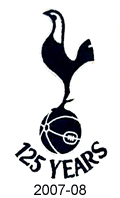 In 2007 Spurs celebrated their 125th anniversary, adopting a special kit for some games modeled on their 1884 halved shirts. For the 2007-08 season the legend "125 Years" was embroidered below the badge. The crowning achievement of the season was the team victory in the League Cup final over Chelsea, a reminder of Spurs long cup-winning tradition.
In 2007 Spurs celebrated their 125th anniversary, adopting a special kit for some games modeled on their 1884 halved shirts. For the 2007-08 season the legend "125 Years" was embroidered below the badge. The crowning achievement of the season was the team victory in the League Cup final over Chelsea, a reminder of Spurs long cup-winning tradition.
Of all the Puma kits worn by the team, their last (2011-12) retro-influenced version was probably the finest. In 2012 Under Armour, kit suppliers to the Welsh national rugby team, took over with an all-white strip with innovative silver-grey trim.
A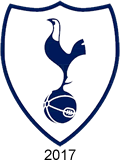 t the end of 2016-17 Spurs quit White Hart Lane to make way for a new 61,500 capacity stadium to be built next door. Within a week demolition started on the old ground to accomodate the new development. Spurs would play at Wembley while the work was completed.
t the end of 2016-17 Spurs quit White Hart Lane to make way for a new 61,500 capacity stadium to be built next door. Within a week demolition started on the old ground to accomodate the new development. Spurs would play at Wembley while the work was completed.
Nike took over as technical partner for the 2017-18 season in a deal rumoured to be worth three times as much as the £50m Under Armour contract. The classic design introduced for that season included a revised crest that mounted the cockspur once again on a shield. This was retired after one season and the previous version reappeared.
Spurs finished second in 2016-17 and reached the UEFA Champions League final in 2019, where they lost to Liverpool 2-1. They qualified for the Champions League again in 2021-22 after finishing fourth and yet again in 2024-25 after placing fifth in 2023-24. Despite this relative success, trophys remained elusive.
* The long sleeved shirts also appeared four times in 1962-63 during cold weather.
Sources
- (*) Graphic by Daniel Stoker
- (a) Official Tottenham Hotspur Website
- (b) Sporting Heroes
- (c) True Colours (John Devlin 2005)
- (d) Andy Porter (THFC Historian)
- (e) Pete's Picture Palace
- (f) David King
- (g) Alick Milne
- (h) Steve Czyrko provided details of the badge worn 1920-1965
- (i) Simon Monks
- (j) Dick Waite
- (k) Willie Kay
- (l) football-shirts.co.uk
- (m) Dean Harding
- (n) Tony Sealey
- (o) Jonathon Russell
- (p) Keith Ellis
- (q) The History of Tottenham Hotspur FC 1882-1921 provided by Richard Essen
- (r) Lilywhite & Blue, the 100% Unofficial History of Tottenham Hotspur's Famous Shirt (available on this link)
- (s) Tottenham Weekly Herald 1921 provided by Tony Sealey
- (t) Tony Sealey & Richard Essen
- (u) The Spurs Shirt (Simon Shakeshaft, Daren Burney, Neville Evans 2018)
Information on Spurs' early crests provided by Andy Porter/Tony Sealey. Crests are the property of Tottenham Hotspur FC.
